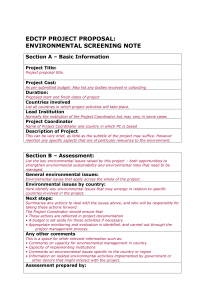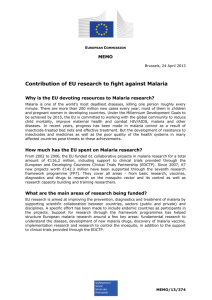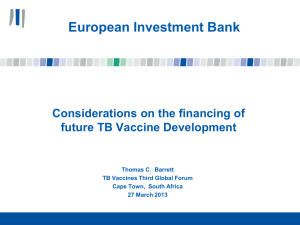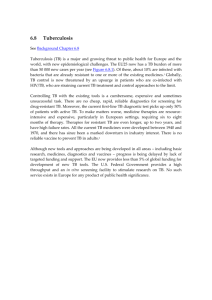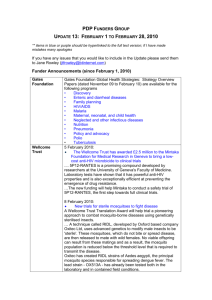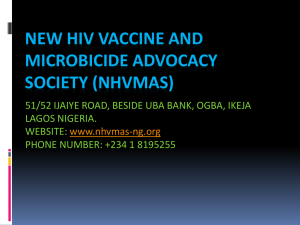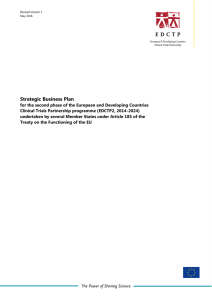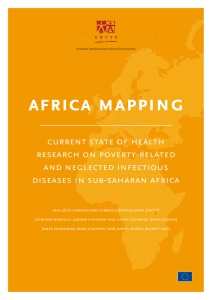Page title
advertisement
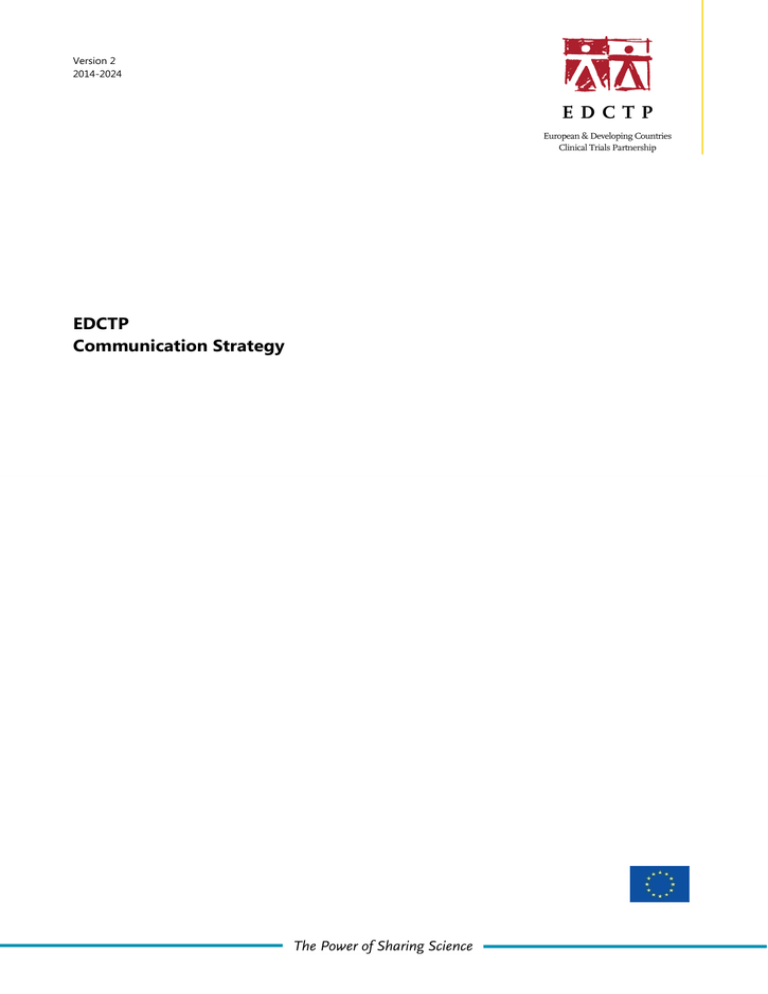
Version 2 2014-2024 EDCTP Communication Strategy 1 EDCTP.............................................................................................................................................................................. 4 1.1 Who we are ......................................................................................................................................................... 4 1.2 Our mission ......................................................................................................................................................... 4 1.3 What we do......................................................................................................................................................... 4 1.4 Our programme objectives ........................................................................................................................... 5 2 Communication strategy and objectives ........................................................................................................... 5 3 Communication objectives ..................................................................................................................................... 6 3.1 Goal and general objectives ......................................................................................................................... 6 3.2 Specific communication objectives ........................................................................................................... 6 4 Values of communication ........................................................................................................................................ 6 4.1 Our slogan........................................................................................................................................................... 7 4.2 Keywords of corporate branding................................................................................................................ 7 4.3 Languages of communication ..................................................................................................................... 7 5 Audiences ...................................................................................................................................................................... 7 5.1 External stakeholders ...................................................................................................................................... 7 5.2 Internal stakeholders ....................................................................................................................................... 9 6 Target groups and key messages......................................................................................................................... 9 6.1 External relations and fundraising ............................................................................................................. 9 6.1.1 Policy makers and public sector .......................................................................................................... 10 6.1.2 For-profit private sector/ pharmaceutical companies ................................................................. 11 6.1.3 Non-profit private sector / philanthropic organisations ............................................................ 12 6.1.4 Public Private Partnerships (PPPs) ....................................................................................................... 12 6.1.5 International Funders ............................................................................................................................... 13 6.1.6 Non-profit organisations ........................................................................................................................ 13 6.1.7 The scientific community in general .................................................................................................. 13 6.1.8 General public and civil society ............................................................................................................ 14 6.2 Communities in developing countries.................................................................................................... 14 6.3 Internal target groups................................................................................................................................... 15 7 Communication tools and activities .................................................................................................................. 16 7.1 Corporate identity .......................................................................................................................................... 16 7.2 Communication tools.................................................................................................................................... 16 7.2.1 Newsletter .................................................................................................................................................... 16 7.2.2 Website.......................................................................................................................................................... 16 7.2.3 EDCTP mobile app .................................................................................................................................... 16 7.2.4 Reports .......................................................................................................................................................... 16 7.2.5 Brochures & factsheets ........................................................................................................................... 16 7.2.6 Videos and photo gallery ....................................................................................................................... 17 7.2.7 Project Portfolio Book .............................................................................................................................. 17 7.2.8 Adverts........................................................................................................................................................... 17 7.2.9 Posters/banners ......................................................................................................................................... 17 7.2.10 Press portfolio........................................................................................................................................ 17 7.2.11 EDCTP Alumni platform ..................................................................................................................... 17 7.2.12 Social media ........................................................................................................................................... 17 7.2.13 Brand Manual and House style guidelines ................................................................................. 17 7.2.14 Other ......................................................................................................................................................... 18 7.3 Schedule for the communication tools .................................................................................................. 18 EDCTP Communications Strategy -2- Version 2 8 Communication Plan and Evaluation ................................................................................................................ 18 8.1 Brand recognition........................................................................................................................................... 18 8.2 Awareness of achievements ....................................................................................................................... 18 8.3 Media coverage............................................................................................................................................... 19 8.4 Website and intranet..................................................................................................................................... 19 8.5 Internal communications ............................................................................................................................. 19 8.6 Good communication service .................................................................................................................... 19 9 Annexes ........................................................................................................................................................................ 20 10 Acronyms ..................................................................................................................................................................... 21 EDCTP Communications Strategy -3- Version 2 1 EDCTP 1.1 Who we are The European & Developing Countries Clinical Trials Partnership (EDCTP) is a public-public partnership between countries in Europe and sub-Saharan Africa and the European Union (EU). EDCTP is governed by the Participating States (PSs: i.e. the countries that are a member of the EDCTP Association) through the General Assembly of the EDCTP Association. Representatives of the European Commission (EC), the African Union (AU) and the World Health Organization (WHO) are observers. The European PSs include Austria, Denmark, Finland, France, Germany, Ireland, Italy, Luxembourg, the Netherlands, Norway, Portugal, Spain, Sweden, and the United Kingdom. The African PSs are: Burkina Faso, Cameroon, Congo, Gabon, The Gambia, Ghana, Mali, Mozambique, Niger, Senegal, South Africa, Tanzania, Uganda, and Zambia. Switzerland is an aspirant member of the EDCTP Association. EDCTP was incorporated under Dutch law as an association. The EDCTP Association is the legal structure to execute the tasks the EU has entrusted to EDCTP. The current second EDCTP programme (EDCTP2, 2014-2024) is implemented as part of the European Framework Programme for Research and Innovation, Horizon 2020. EDCTP operates under Article 185 of the Treaty on the Functioning of the European Union (TFEU) and is funded jointly by the European Union (EU) and the Participating States (PSs). The EU’s financial contribution to EDCTP2 will match the contributions of European Participating States (PSs) up to a maximum amount of €683 million. The Partnership aims for a €2 billion budget having already secured €1.36 billion in pledges. Additional funding will be sought from public and private third parties. EDCTP is a non-profit organisation. It was established in 2003 as a research programme undertaken by 16 European countries with the support of the European Union in response to the global health crisis caused by HIV, tuberculosis and malaria. It was the largest programme targeting clinical trials in sub-Saharan Africa under the EU’s 6th Framework Programme for Research. The first EDCTP programme closed in December 2015. 1.2 Our mission The EDCTP mission is: To reduce poverty in sub-Saharan Africa through improved health by funding collaborative research to accelerate the development of new or improved medical interventions against poverty-related and neglected infectious diseases. 1.3 What we do We fund research in sub-Saharan Africa to accelerate the clinical development of effective, safe, accessible, suitable, and affordable medical interventions for poverty-related and neglected infectious diseases, including diarrhoeal infections, lower respiratory infections, and yellow fever as well as emerging infectious diseases of particular relevance to sub-Saharan Africa, such as Ebola. We support international alignment, coordination and integration of national research agendas and programmes for poverty-related and neglected infectious diseases. We seek the advice, support and collaboration of many stakeholders including research institutions, development organisations, private charities and funders, pharmaceutical companies, and product development partnerships. EDCTP Communications Strategy -4- Version 2 We offer a single European-African platform for research cooperation and funding. We promote African co-ownership of the EDCTP programme and the development of clinical research capacity and scientific leadership in sub-Saharan Africa. We support sub-Saharan African countries with the development of their capacity to conduct clinical trials in compliance with fundamental ethical principles and relevant (inter)national standards and regulations. 1.4 Our programme objectives The programme objective is to accelerate development of new or improved tools (drugs, vaccines, microbicides and diagnostics) against the PRDs through phase I-IV clinical trials, with a focus on phase II-III. Through the collaborative research we fund, we aim to facilitate cooperation and integration of relevant European national research programmes and activities, and extend this cooperation to other public and private third parties, always in partnership with sub-Saharan African countries, research institutions and scientists. The EDCTP2 Programme includes the following five specific programme objectives: 1. Support clinical trials and related activities targeting poverty-related infectious diseases, namely HIV, tuberculosis, malaria and the neglected infectious diseases (NIDs); 2. Support capacity development for clinical trials and related research in sub-Saharan Africa through grants for career development of junior and senior fellows; mobility and staff exchange; research training networks; strengthening ethics and regulatory bodies; and mentoring and partnerships; 3. Promote networking, coordination, alignment, collaboration and, where possible, integration of national research programmes and activities on poverty-related infectious diseases at scientific, management and financial level; 4. Establish cooperation and launch joint actions with other public and private funders; 5. Assure awareness, endorsement and acknowledgment of the EDCTP2 Programme and its activities through advocacy and communication, not only within the EU and developing countries, but also globally. 2 Communication strategy and objectives Under its first programme, EDCTP already demonstrated to go beyond political statements of good intentions as evidenced by the successful implementation of activities both in Europe and sub-Saharan Africa. EDCTP is now a flagship European-African partnership and a recognised global player in supporting clinical trials for HIV, TB and malaria and related research capacity development in sub-Saharan Africa. EDCTP is a niche player with a clear focus. In order for the programme to get the required support and visibility, EDCTP needs to scale up its information sharing on the organisation’s success stories, progress on funded activities and project outcomes. Communication content and strategies need a combination of scientific, political and developmental input. Its overall message should be that EDCTP provides a platform which facilitates and ensures that through direct engagement of partners, clinical trials are conducted according to all relevant international standards and under the best possible conditions for the populations concerned. A particular communication challenge arises from the highly technical character of information regarding clinical trials and the perceptions – many of them negative – surrounding clinical trials, especially when conducted in developing countries. The non-specialist and the general public need to have access to clear and accurate information about EDCTP’s mandate, modus operandi to achieve our mission and goals. Clarifying EDCTP’s philosophy, principles and ethics is just as important as stating the objectives and activities of EDCTP. EDCTP Communications Strategy -5- Version 2 Secondly, EDCTP is involved in an arena where multiple actors are involved in activities either upstream or downstream of the clinical trials stage. Therefore, the existing public relations efforts in relation to these (potential) partners must continue to be scaled up to ensure collaborative rather than competitive working relationships. Thirdly, EDCTP will not be able to achieve its goals through the influence of the funding relationships alone. To a large extent, the North-North, North-South and the South-South coordination and networking activities rely mainly on advocacy activities including public relations Therefore, the EDCTP communication strategy is an essential part of EDCTP activities and needs to be aligned with the overall programme objectives. 3 Communication objectives 3.1 Goal and general objectives Advocacy and communication – the fifth specific programme objective – aim to secure moral and financial support to sustain the objectives and activities of EDCTP by: Creating and maintaining awareness and visibility for EDCTP, its mission and goals; Keeping all stakeholders regularly informed of the progress and outcomes of EDCTP supported activities; Creating awareness to mobilise private and political support Generating ownership and partnership amongst stakeholders Advocating for substantial additional funding for EDCTP Brokering of initiatives for joint activities in order to accelerate the development of new or improved clinical tools. 3.2 Specific communication objectives The specific communication objectives include: To communicate EDCTP’s focus on clinical trials and capacity development to fight HIV, tuberculosis, malaria and neglected infectious diseases, ensuring adherence to the highest scientific, ethics and regulatory standards; To raise political awareness of EDCTP to ensure long-term support of the programme; To position and maintain EDCTP as a unique research partnership between Europe and sub-Saharan Africa; To demonstrate the uniqueness and added value of the Partnership as a major global player in the fight against HIV, tuberculosis, malaria and neglected infectious diseases through practical outputs; To timely inform all stakeholders of the outcomes of EDCTP-funded activities; To engage in joint advocacy efforts with third parties. 4 Values of communication EDCTP aims to give the right information, to the right people, at the right time, through the right channels. Our key communication values are: Transparency and Integrity: EDCTP aspires to be transparent about its decision making and activities adhering to the highest levels of integrity, and, at all times, will comply with relevant legislation. Accessibility and timeliness: Persons communicating on behalf of EDCTP should, at all times, be friendly, polite, timely and as helpful as possible, in their dealings with all stakeholders. EDCTP should be easily contactable and clear about its responsibilities. Equality and inclusivity: EDCTP will not inappropriately favour one stakeholder over another, and will ensure efforts are made to communicate with the widest possible communities in Europe and Africa, including hard-to-reach groups. Clear branding: All EDCTP communications should be clearly identifiable. EDCTP Communications Strategy -6- Version 2 Integration with EDCTP core business: EDCTP communications must form an integral part of the EDCTP2 strategic business plan and annual planning process. Cost-effectiveness: EDCTP always aims to ensure best value. 4.1 Our slogan “The power of sharing science” The slogan reflects the key values of EDCTP: Empowerment Partnership and networking Mutual trust Transparency Innovation Best practices Responsibility 4.2 Keywords of corporate branding Keywords are chosen to portray and communicate EDCTP’s corporate image, identity and values. These include appropriate words for our website and communication tools such as brochures, pamphlets, factsheets, posters and the newsletter. Furthermore, these keywords should evoke the appropriate emotions that we require from EDCTP stakeholders when they look at the ‘face’ of the programme. 4.3 Languages of communication English is the working language of EDCTP and the main language for its communication. When necessary, appropriate documents will be will be translated into French and Portuguese. Other languages may also be used for specific purposes. 5 Audiences EDCTP has identified various categories of stakeholders, both internally and externally, that can be targeted. The table below identified these key target groups and the communication objectives. 5.1 External stakeholders Stakeholders Communication objectives General public and civil society Patients groups, public and private health service providers, health community workers (physicians, nurses etc.), study volunteers, research trial participating communities, The East, Central and Southern African Health Community (ECSA), consumer groups/activists/advocate groups (INTERACT), media Policy makers African and European governments, political alliances (African Union), New Economic Partnership for African Development (NEPAD), African regional economic communities and their health sections (West African Health Organisation (WAHO), heads of states, ministries of Health, Finance, Science & Technology, Inputs into product/trial design, knowledge-based participation in trials application/use of trial results, facilitate the conduct of trials, Understanding the importance of research to improved health services and health outcomes, influencing the political agenda on health issues EDCTP Communications Strategy -7- Political support Resources: human infrastructure funds, raise the visibility of EDCTP, institutionalised research capacity towards sustainable development and increase political support by promoting the full and equal role of the African partnership Version 2 Higher Education, ambassadors, regional and local community leaders both in Europe and Africa, Africa and EU countries not yet members of the EDCTP Association, Network for better health and policy (INDEPTH), opinion leaders/makers : science and technology options assessment (STOA) disease control programmes National and international public funders African Development Bank (AfDB); European Investment Bank (EIB); European and African Participating States; International Monetary Fund (IMF); UNITAID; World Bank; development aid partners. Scientific/Research Community Scientific community (public and private) Ethics groups, associations of physicians, scientific societies Regional and national regulatory agencies Academia, medical colleges, etc. National research institutions, Responsible innovation research programmes (NWO-MVI) EDCTP Grant applicants; EDCTP grantees Private sector For-profit private sector Pharmaceutical industry; other commercial companies Product developers (including biotech companies) Small to medium-sized enterprises (SMEs) Non-profit private sector Philanthropic organisation like the Bill & Melinda Gates Foundation, the Calouste Gulbenkian Foundation, La Caixa Foundation, Rockefeller Foundation, Wellcome Trust Public-Private Partnerships Joint research/funding initiatives IMI, EVI ANDi, the CAPTN vaccine initiative GAVI Global Fund for malaria, TB and AIDS South African AIDS Vaccine Initiative (SAAVI) Enhancing Support for Strengthening the Effectiveness of National Capacity Effort (ESSENCE), The malaria, HIV and TB vaccine funders’ forums, Multilateral Initiative on Malaria (MIM) Product Development Partnerships (PDPs): AERAS, DNDi, FIND, PATH, IAVI, MMV,TB Alliance, IPM Non-profit organisations Governmental or non-governmental international organisations: United Nations agencies (WHO, WHO/AFRO, UNAIDS), COHRED, SDH-Net, MSF, etc. EDCTP Communications Strategy -8- Ensure support for funding, and coordination of funding to maximise synergy Ownership of EDCTP’s vision/mission, influencing policy and practice by directing the process of prioritising research needs, defining solutions and guiding product/trial design Support for EDCTP projects either through cash or in-kind through provision of investigational products, serving as clinical trials sponsors or provision of clinical trials related specialised training and mentorship support (resources) Contribute to product design and influence policy and practice Shared resources and approaches, coordination to maximize synergies/reduce duplication, cohesion in support to/involvement of countries, coordination to serve national priorities and combined information and advocacy efforts for better results in communication and fundraising. Ensure support for funding, and coordination of funding to maximise synergy Support for EDCTP’s vision/mission Resources Version 2 5.2 Internal stakeholders Stakeholders Communication objectives EDCTP constituencies General Assembly of the EDCTP Association EDCTP Board EDCTP Executive Secretariat EDCTP Scientific Advisory Committee* Informal Advisory workgroups* European Commission* Ambassadors for EDCTP’s vision/mission: common understanding of operational constraints and progress; realistic expectations; active participation/involvement; common understanding of mission/goals, modus operandi; ensuring good cooperation (* grouped under internal target groups but are external to the EDCTP Association) 6 Target groups and key messages The external and internal stakeholders of EDCTP constitute its target audience. The main communication activities aimed at EDCTP target groups will be organised around three main themes: External relationship: to enhance awareness or visibility of EDCTP Brokerage between different initiatives to acquire additional funds: such funds are needed to support projects to accelerate the development of new clinical tools and promote uptake Fundraising: development of innovative mechanisms for encouraging cofunding of projects within the scope of EDCTP2. EDCTP needs to seek synergies and complementarities with partners dealing with clinical development of new medical interventions and capacity building in sub-Saharan Africa. 6.1 External relations and fundraising Following from the achievements of its first programme, EDCTP is becoming a recognised global player in the development of new interventions against diseases of poverty. More work however needs to be done to build more confidence and trust with many of the product development partners who normally do business with long-term product development strategies and plans. Moreover, of benefit to all EDCTP stakeholders, more work needs to be done to show case the success stories and timely sharing of information on the progress and achievements of the EDCTP programme. Raising funds for EDCTP is no small challenge to meet. Private and public stakeholders generally regard public-backed institutions such as EDCTP as a source of funding rather than as a potential recipient thereof. To convince industry or large foundations to contribute funding to, or via, EDCTP, it will be necessary to demonstrate the added value gained by EDCTP’s involvement. Primary targets for mobilisation of resources include bilateral agencies, multilateral financial institutions, and non-profit organisations. The contributions should preferably be in cash, but can also be in-kind. Developing countries will also be targeted, in particular the EDCTP Participating States in sub-Saharan Africa. Dialogue will be initiated at all levels of administration to allow the decision makers in participating developing countries to recognise the importance of the proposed research and to consider the benefits of including support to EDCTP activities in their budgets. Such measures are critical for the long-term sustainability of the clinical trial sites. The advocacy role of the EDCTP High Representatives will be complemented by the Director of North-North Cooperation (DNNC), the Director of South-South Cooperation (DSSC) and the Executive Director (ED). EDCTP Communications Strategy -9- Version 2 Development of new innovative methods for resource mobilisation in collaboration with private and institutions, as well as the general public, will be a closely linked to EDCTP’s advocacy work and will proceed with due consideration for the individual requirements of EDCTP member countries with respect to these methods. EDCTP acts as primary player and as a good faith broker or intermediary to bring parties together to consider and negotiate ways of proceeding. EDCTP has developed a strategy for enhancing cooperation with private industry and its implementation is led by the DNNC. 6.1.1 Policy makers and public sector 6.1.1.1 Governments-Development Organisations Communication objectives: 1. Knowledge: To ensure that they are well informed of the EDCTP mission & vision and that progress outcomes of the programme are clear as well as they are aware of the magnitude of the problem that EDCTP is tackling. 2. Attitude: To convince European Union member states, Canada and USA and other G7 and G20 members that the EDCTP strategy is the best and that combining funds and efforts is the most efficient and effective way to fight PRNDs. This conviction will replace the fear of loss of control over national interests and funds. To convince the African partners that the EDCTP programme is longterm and there must be African ownership and leadership. 3. Behaviour: To establish cooperation with the aim of securing release of funds on a regular basis and provision of competent individuals to join and participate in the EDCTP action ensuring projects sustainability. To convince public sector stakeholders that they are part of the EDCTP programme and that the projects are long-term and should be supported in a sustainable manner for as long as necessary, even after termination of EDCTP. Key message: Invest in people; invest your time and money through EDCTP since through the coordinated and integrated programme we can now synergise and optimise our efforts. Best ways to reach these groups: We need different strategies for different countries. The various approaches should be determined through the advice of the EDCTP-Association General Assembly members. 6.1.1.2 Ministers of health, research, science, technology and development Communication objectives: 1. Knowledge: To ensure that the ministers concerned and the policy and decision makers, especially in Europe and Africa, know about the work and achievements of EDCTP in R&D. To reassure them that the findings arising from EDCTP projects will be made public and available to everyone and will not be exploited for commercial purposes since they arise from public funding. 2. Attitude: To convince them that the EDCTP strategy is the best; that combining funds and efforts for R&D is the most efficient and effective way to fight PRDs. 3. Behaviour: To convince Participating States to phase out national programmes on PRDs and to increasingly participate in the joint programme. Key message: Joint R&D programme creates synergy, efficiency and removes redundancy and repetitions. Best way to reach those involved in R&D at political level: Each country will need a specific approach as to be advised by members of the Assembly. 6.1.1.3 Technical level audiences Research administrators EDCTP Communications Strategy - 10 - Version 2 Grant applicants Grantees Proposal reviewers Communication objectives: 1. 2. 3. Knowledge: To ensure that potential applicants, grantees and reviewers of proposal are wellinformed of the mission, vision, grant awarding philosophy and regulations of EDCTP. Attitude: To ensure that applicants, grantees and reviewers are convinced that the EDCTP strategy is the best and most efficient way of way to fight PRNDs. Behaviour: To ensure their cooperation in timely review, reporting and conduct of the EDCTP sponsored research. To ensure that applicants, grantees and reviewers follow best practices and adhere to these through all stages, from grant application to completion. Key message: EDCTP is relevant and is making a difference for the better in developing countries. The upholding of best practises and maintaining of transparency is of paramount importance in securing confidence of all our stakeholders. Best way to reach applicants, grantees and reviewers: Demonstrate reliability, programmes sustainability, transparency and encourage ownership of all stakeholders, while proving to applicants and grantees that EDCTP programme is on track and addressing real issues that matter to those living in poverty-related disease endemic areas. 6.1.2 For-profit private sector/ pharmaceutical companies Pharmaceutical companies involved or not involved in poverty-related and neglected diseases Communication objectives: 1. Knowledge: To ensure that the pharmaceutical industry is informed of the EDCTP mission and vision and that progress outcomes are alive and clear. 2. Attitude: To ascertain that the pharmaceutical industry regards EDCTP as an effective partner for developing new interventions to alleviate the burden of poverty-related and neglected diseases. To make them realise or remind them of their moral obligation to society, especially to Africa. 3. Behaviour: o To gain the support of the industry in providing sustainable capacity building by training personnel including clinical monitors and data managers. o To encourage the industry partners to make products developed for poverty-related and neglected diseases accessible and affordable in developing countries. o To solicit their support of EDCTP through providing funds and assistance in-kind through activities such as training. Key message: You can do something to fulfil your moral obligation; supporting EDCTP is the ideal way to improve your image. We should avoid duplication and instead develop a joint win-win deal. Best way to reach the pharmaceutical industry The best way to approach this group is by demonstrating how EDCTP can support the development of new interventions of interest for industry. This could include joint activities for training and mentorship of personnel from developing countries, providing investigational products at no cost and asking them to assume clinical trials’ sponsor responsibilities as well as including financing or co-financing clinical trials activities. Training of African personnel in fields such as data management, biostatistics, clinical trials monitoring, budget forecasting for clinical trials, project and risk management will create a critical mass of experts who through North-South and South-South collaborations and mentorship as well as networks of EDCTP Communications Strategy - 11 - Version 2 excellence will generate further expertise and ensure sustainability of the programme. Approach the most criticised firms at the right time. In order to do so, we need right contact persons who are well informed and have influence in the field of sponsorships and fundraising. This will be implemented through networking teams. 6.1.3 Non-profit private sector / philanthropic organisations Philanthropic organisation like Bill & Melinda Gates Foundation, Calouste Gulbenkian Foundation, La Caixa Foundation, Rockefeller Foundation, and Wellcome Trust. Communication objectives: 1. Knowledge: To ensure that these organisations are well informed of the EDCTP mission, vision and progress and outcomes are alive and clear 2. Attitude: To ensure that they should regard EDCTP as a partner in advocacy and networking. To convince these organisations that combining funds and the efforts is the most efficient and effective way of fighting PRNDs. 3. Behaviour: To ensure that the organisations do actually work together with EDCTP in advocacy, networking and fundraising. Key message: We should join forces and avoid duplication; we should have a win-win deal. Best way to reach philanthropic organisations: Approach with appropriate proposals those organisations that are already involved in one or more of the three PRDs. In order to do so we need right contact persons. 6.1.4 Public Private Partnerships (PPPs) Product development partnerships (PDPs) Small single product collaboration with industry Large entities hosted in UN agencies or private non-profit organisations Communication objectives: 1. 2. 3. Knowledge: To ensure that PPPs actors are well-informed of the EDCTP mission and vision and are aware of the achievements of EDCTP in R&D. To inform them that the findings arising from EDCTP projects will be made public and available to everyone, and will not be exploited for commercial purposes. Attitude: To convince them that the EDCTP strategy is the best and jointly supporting R&D is the most efficient and effective way to fight the PRNDs. To ensure that these PPPs actors regard EDCTP as an active partner for clinical trials rather than a passive funder. To convince that joint effort is the most efficient and effective way to persuade donors to provide funds. Behaviour: To ascertain that these PPPs actors do actually work together with EDCTP in clinical trials, joint fundraising and advocacy activities. Key message: Joint R&D programme creates synergy, efficiency, removes redundancy and accelerate product development and deployment. Therefore let us raise funds and conduct business together. We are the ideal partner for clinical trials. Best way to reach PPPs actors: Identify PPPs that work on PRNDs and approach PPPs actors with appropriate proposals for joint fundraising activities and action. Openly sharing ongoing and achievements activities with selected Public-Public Partnerships (PPPs) with similar goals. EDCTP Communications Strategy - 12 - Version 2 6.1.5 International Funders World Bank, IMF, EIB, AfDB Communication objectives: 1. 2. 3. Knowledge: To ensure that international funding bodies are well-informed of the EDCTP mission and vision and clearly aware of progress and outcomes. To ensure that they are aware of the magnitude of the problem that EDCTP is tackling. Attitude: To ensure that they are convinced that the EDCTP strategy is the best; that combining the money and the efforts is the most efficient and effective way to fight target diseases. Behaviour: To ensure their cooperation in giving funds on a regular basis. Key message: Give Africa the opportunity to take leadership since this will ensure success and sustainability. Have confidence in this international partnership. Best way to reach international funding bodies: Prove to the international funding bodies that EDCTP partners are successfully working together. Reach the G7/G20 through the High Representatives. 6.1.6 Non-profit organisations Governmental or non-governmental international organisations (WHO, UNAIDS, COHRED, SDH-Net and others) Communication objectives: 1. 2. Knowledge: To ensure that international organisations are familiar with the work and achievements of EDCTP in R&D. To reassure them that the findings arising from EDCTP projects will be made public and available to everyone, and will not be exploited for commercial purposes. Attitude: To convince them that the EDCTP strategy is the best; that combining efforts in R&D is the most efficient and effective way to fight the PRNDs. Key message: EDCTP promotes acceleration of R&D of the PNRD intervention products. Best way to reach international organisations: Inform the international organisations of the EDCTP role in R&D and of its achievements in this. 6.1.7 The scientific community in general Communication objectives: 1. 2. Knowledge: To ensure that the global scientific community know about the work and achievements of EDCTP. To ensure that the scientific community both at technical and political level is wellinformed of the EDCTP mission and vision and that the progress and outcomes are alive and clear. To ensure that the scientific community, especially at the political level is aware of the magnitude of the problem that EDCTP is tackling. Attitude: To ensure that the scientific community is convinced that the EDCTP strategy is the best; that combining money and efforts is the most efficient and effective way to fight the PRNDs. EDCTP Communications Strategy - 13 - Version 2 3. Behaviour: To ensure the cooperation of the scientific community at the political level in giving funds for R&D on a regular basis. To convince PSs to phase out national programmes on PRNDs and to increasingly participate in the joint programme. Key message: The best way to combat PRDs in developing countries is through the integration of the European national programmes in partnership with the developing countries themselves. Joint programme creates synergy and optimises outcomes. Best way to reach research community: Demonstrate that a joint European programme in partnership with African counterparts is the most efficient and cost-effective way of utilising funds and in combating poverty-related and neglected diseases in Africa. Increase awareness of the philosophy behind and the value of the EDCTP model of partnership among Participating States through (deputy) representatives to the General Assembly and advocate for increasing joint projects and co-funding. 6.1.8 General public and civil society Communication objectives: 1. Knowledge: To ensure that the general public and civil society understand the importance of research for improved health services and health outcomes in all countries. 2. Attitude: To create positive expectations regarding sub-Saharan African scientists and research; to influence the political agenda on health issues, especially on the value of investing in clinical research and research capacity in sub-Saharan Africa; to have EDCTP perceived as an excellent model of investing in health research, that combines funds and effort in the most efficient and effective way to fight PRNDs. 3. Behaviour: To support the EDCTP programme and strategy; to support an international, collaborative approach to health research and prevention of health crises and emerging threats of global epidemics. To support sustained funding of the EDCTP programme. To convince civil society that EDCTP is worth supporting, protecting and strengthening which ideally results in a willingness to support EDCTP through, for example, petitions, donations or crowd-funding. Key message: Invest in health research and take responsibility for a common humanity, for global citizenship; invest your support and money through EDCTP as the poverty-related diseases are global threats that need global solutions in everybody’s interest. Best ways to reach these groups: We need different strategies for different audiences in countries. The various approaches should be determined based on media analysis and also on the advice of journalists, opinion leaders from civil society as well as the EDCTP-Association General Assembly members. 6.2 Communities in developing countries Political and administrative level Public health system level National Regional Local Civil society. Communication objectives: EDCTP Communications Strategy - 14 - Version 2 1. 2. 3. Knowledge: To ensure that the relevant levels of the communities in the developing world are well informed of the EDCTP mission, vision and activities as necessary. To inform communities that the aspiration of EDCTP is to develop sustainable, affordable, accessible and appropriate interventions against PRDs within the remit of the programme. Attitude: To ensure that communities are aware of the magnitude of the problem that EDCTP is tackling and that it can only be solved if they accept ownership and responsibilities in finding solutions. To convince developing countries communities that the programme is long-term and for its success, it will also require long-term local commitment. Behaviour: To establish cooperation with African leadership with the aim of securing empowerment and creating sustainable capacity. Key message: The partnership is mutual and for it to succeed and be sustainable there must be strong inputs from developing countries in terms of leadership and commitment. Best way to reach developing country communities: Showing long-term commitment and working closely with African scientific community, African leadership and African initiatives such as NEPAD through African GA and SAC representatives, High Representative for Africa and EDCTP Africa Office. 6.3 Internal target groups General Assembly EDCTP board Scientific Advisory Committee Ad-hoc advisory working groups on specialised topics European Commission. Communication objectives: 1. 2. 3. Knowledge: To ensure that internal groups are well informed of the work of the Secretariat and its relationship with all other constituents. Attitude: To make them aware of the close working relations with the Secretariat and with each other; relations that are based on confidence and mutual trust. Behaviour: To ensure that all internal groups are proactively involved in the activities of EDCTP, especially in those that form part of their responsibilities. Best way to reach the internal target groups For all Constituencies, the best way to reach them and thereby realise the communication objectives the following approaches will be used: Direct personal contact with the Chairs and Vice-Chairs of the Constituencies on a monthly basis Direct personal contact with the members of the Constituencies through regular meetings and telephone conferences Frequent contact with members of each Constituency through participation in EDCTP-activities Regular contact with members of the EDCTP Board Meeting through teleconferencing Written information, e.g. the EDCTP newsletter, biannual summary updates and interaction through the EDCTP website. Main points to use as the means of communication For each Constituency, an EDCTP Officer has been appointed as focal person responsible for the communication link. All the information for this section will be processed through this person – who thereby serves as an account manager. EDCTP Communications Strategy - 15 - Version 2 To create a basis of mutual trust, it is essential that all the information from each Constituency should be made available to other Constituency members. This is what is referred to as the “library-function” of the EDCTP SharePoint intranet. In addition, it is important to present in an attractive, easy to follow ‘digest’ some information, or at least some of the headlines. This may be in the form of an internal newsletter. Another important means of communication will be the Constituency SharePoint, whereby all Constituency members will be able to function as senders as well as receivers. Such a site will increase ownership of the information and therefore increase the involvement of the various members as well. It will lead to more interaction in and between the different layers of EDCTP. All members of a Constituency will be provided with approved material to fulfil their advocacy roles. This will be prepared in the form of PowerPoint presentation slides, brochures, pamphlets and posters by the Secretariat. 7 Communication tools and activities 7.1 Corporate identity EDCTP has developed various communication methods for advocacy and dissemination of information. 7.2 Communication tools Communication means with a high priority include the following: 7.2.1 Newsletter Electronic and print newsletter in English; electronic version also in French and Portuguese News alerts 7.2.2 Website News items regarding EDCTP activities and results from EDCTP-funded projects and other activities Information on calls for proposals Information on EDCTP governance and constituencies Information regarding legal obligations of EDCTP (privacy, procurement, etc.) Information to support applicants and grantees (guidelines and other resources) Information from the EDCTP grants management system will be selectively published on the website (key project data and summary) The website is responsive to various platforms 7.2.3 EDCTP mobile app An EDCTP application (app) for tablets (Android and iOS systems) allows quick access to most EDCTP publications and offers a mobile library of EDCTP’s digital resources in PDF format. 7.2.4 Reports Annual Report and (Summary) Financial Statements available in electronic format (PDF and interactive) and in print Strategic Business Plan with an executive summary Stakeholder and high-level meeting reports on the website and in print Reports on (commissioned) research on the website and in print. 7.2.5 Brochures & factsheets Brochures on EDCTP and other broad topics Fact sheets to support specific communication and networking activities EDCTP Communications Strategy - 16 - Version 2 7.2.6 Videos and photo gallery EDCTP YouTube channel (www.youtube.come/edctpmedia) Photo library: high quality photographs to be used for EDCTP publications, regularly updated. 7.2.7 Project Portfolio Book EDCTP1; available in electronic format 7.2.8 Adverts Calls for proposal Vacancies. 7.2.9 Posters/banners Posters and other communication materials, developed to support EDCTP representation at meetings and events. 7.2.10 Press portfolio Press documentation: Fact sheets Photographs Articles Background information (both on the website and in print). 7.2.11 EDCTP Alumni platform A need has been identified to establish a platform for ‘Alumni’ of the EDCTP Fellowships. This platform is aimed to enhance South-South and North-South cooperation with an ultimate goal of promoting African scientific leadership and fostering scientific excellence through collaborative research. This platform will be supported by a web platform for sharing information. 7.2.12 Social media The EDCTP Twitter account (www.twitter.com/EDCTP) 7.2.13 Brand Manual and House style guidelines EDCTP visual identity elements Corporate text Editing style and standard terms Use of the European Union emblem Stationery and templates o Folders o Letters o Envelopes o Business cards o Stickers in various formats for cars and laboratory equipment o PowerPoint presentation o General templates o Meeting minutes and reports. EDCTP Communications Strategy - 17 - Version 2 7.2.14 Other Documentary: documentary on clinical trials including the process from start to finish, including ICHguidelines and Swiss guidelines for researchers working in developing countries (on the website) Awards: EDCTP has established four prestigious international prizes dedicated to the promotion of scientific research, improved health and Africa-European collaboration. The awards will be announced every two years at the biennial EDCTP forum. The four awards are: o o o o Scientific Leadership Award: Awarded to excellent world-class scientists in Africa up to up to 50 years of age. Outstanding Female Scientist: Awarded to excellent world-class female scientists working and residing in sub-Saharan Africa in the remit of EDCTP2. Outstanding Research Teams: Awarded to outstanding research teams in Africa and Europe working on HIV, tuberculosis, malaria and neglected infectious diseases (NIDS) in the scope of the EDCTP2 programme. Dr Pascoal Mocumbi Award: This is an award set up in recognition of the work of Dr Pascoal Mocumbi towards the mission of EDCTP. It is to be awarded scientists, policy makers or advocates for health and research from anywhere in the world and has no age restriction. Press strategy: EDCTP should develop a separate press strategy, including the identification of right journalists and their media, both in the Western world and Africa in order to raise enough awareness of EDCTP, the burden of PRDs and the urgent need to fight these diseases as well as to make our results public. 7.3 Schedule for the communication tools Website update: continuously and regularly as the need arises with weekly reviews and monthly evaluations Electronic mailing lists: updates continuously Newsletter: four times a year, in January, April, July and October Press releases: as need arises, but strategically to also target major global events and opportunities (such as the World AIDS Day, the World Malaria Day, the World TB day, World Clinical Trials Day, etc.) as well as EDCTP gatherings (including the biennial Forum, investigators’ meetings and meetings of the EDCTPfunded regional networks of excellence) Joint communications and initiatives with the EC and third parties as opportunity arises. 8 Communication plan and evaluation 8.1 Brand recognition Key objective: to increase brand recognition EDCTP on a regional, national level and international level. EDCTP needs to have a strong approach to brand management. EDCTP’s identity and logo should be effectively monitored and controlled. Production standards for publications need to be consistent in terms of corporate identity and image. Standards for letterheads; e-mail signatures; letter/fax formats. 8.2 Awareness of achievements Key objective: to increase awareness of and showcase the achievements and impact of the EDCTP programme. High percentage of relevant stakeholders who are well informed EDCTP Communications Strategy - 18 - Version 2 Media coverage Stakeholder relations standards and guidelines in place Stakeholder liaison organised and co-ordinated, with good evaluation and feedback by and to ED Proactive liaison with hard-to-reach groups. 8.3 Media coverage Key objective: to increase positive coverage of EDCTP activities through the media. Link media effort and service/policy initiatives on high profile issues Set targets to improve media coverage in Europe and Africa. 8.4 Website and intranet Key objective: tangibly improve the quality of communications delivered through the EDCTP public website/and staff Intranet. Need for rules/standards and effective resourcing to ensure consistent content management and design Website navigation needs to be easy to use for first time visitors Website can make a strong contribution to EDCTP marketing and branding The EDCTP intranet needs to be readable, accessible and interactive for both EDCTP offices (The Hague, Netherlands, and Cape Town, South Africa). 8.5 Internal communications Key objective: to increase EDCTP staff morale, satisfaction and awareness. Ensure that EDCTP staff feel well-informed/in the communications loop Ensure high quality information to support role of High Representative(s) Provide good support to EDCTP staff in order for each one to communicate individually and collectively on behalf of EDCTP EDCTP Senior Management Team (SMT) and Management Team (MT) need to have monthly/bimonthly meetings and all line managers to have monthly one to one meetings with each staff member to identify any matters of concern/personal difficulties Ensure strong support for internal communications at corporate level. HR and communications responsibilities should strongly link with clear targets and accountabilities Internal communications with staff need to be adequately resourced. A relatively modest investment can offer significant benefits in terms of motivation and performance Communications with staff need to be consistent, and both EDCTP offices (The Hague, Netherlands, and Cape Town, South Africa) should be valued equally. 8.6 Good communication service Key objective: to deliver a good communications service, with clear responsibilities, effective use of resources and measured performance management. Need for strong management and co-ordination of communications. Need for collaborative involvement of diverse staff in communications. Need to assess separate marketing/communications roles in departments Communication officers need to have contact persons in all teams Need to establish dedicated corporate communications budget and ensure best value for money. EDCTP Communications Strategy - 19 - Version 2 9 Annexes Listed here are related communications procedures and guidelines: DMS # Document name 94609 How we look. Brand manual (April 2016) 94610 Welcome to the family. EDCTP secretariat brand culture book (April 2016) 29277 EDCTP Media policy 23165 EDCTP Stand manual 78867 EDCTP Website update procedure 91441 EDCTP Standard operating procedures EDCTP Communications Strategy - 20 - Version 2 10 Acronyms Note: descriptions in italics AERAS AESA AfDB AIDS ANDi AU CAPTN COHRED DNDi DNNC DSSC EC ECSA ED EDCTP EDCTP1 EDCTP2 EID ESSENCE EU EVI FIND GAVI G7 Non-profit biotechnology organisation for the development of tuberculosis (TB) vaccines Alliance for Accelerating Excellence in Science in Africa African Development Bank Acquired Immune Deficiency Syndrome African Network for Drug and Diagnostics innovation African Union Canada-Africa Prevention Trials Network Council on Health Research for Development Drugs for Neglected Diseases initiative Director of North-North Cooperation (EDCTP) Director of South-South Cooperation (EDCTP) European Commission East, Central and Southern African (ECSA) Health Community Executive Director (EDCTP) European & Developing Countries Clinical Trials Partnership First EDCTP programme (2003-2015) Second EDCTP programme (2014-2020/2024) European Investment Bank Enhancing Support for Strengthening the Effectiveness of National Capacity Efforts (collaboration of research funders, hosted by TDR) European Union European Vaccine Initiative Foundation for Innovative Diagnostics Global vaccine alliance (public-private) with mission of creating equal access to new and underused vaccines for children living in the world’s poorest countries Group of 7 (countries, i.e. Canada, France, Germany, Italy, Japan, the United Kingdom, and the United States. The European Union is also represented within the G7). G20 Group of Twenty (an international forum for the governments and central bank governors from 20 major economies) INDEPTH IMF IMI IPM HIV HR IAVI MIM MMV MT MSF NEPAD NID NOW-MVI Network for the Demographic Evaluation of Populations and their Health International Monetary Fund Innovative Medicines Initiative International Partnership for Microbicides Human Immunodeficiency Virus Human Resources (EDCTP) International Aids Vaccine Initiative Multilateral Initiative on Malaria Medicines for Malaria Venture Management Team (EDCTP) Médecins sans Frontières / MSF International New Partnership for Africa’s Development Neglected Infectious Disease Nederlandse Organisatie voor Wetenschappelijk Onderzoek- Maatschappelijk Verantwoord Innoveren (Dutch programme for responsible innovation) International non-profit organisation for global health innovation (originally: Program for PATH PDP PPP PRD PRNDs PS Appropriate Technology in Health; as of 2016, simply known as PATH) Product Development Partnership Public-Private Partnership Poverty-Related Disease Poverty-Related and Neglected Diseases Participating State (i.e. member country of the EDCTP Association) EDCTP Communications Strategy - 21 - Version 2 PSIA R&D SAAVI SDH-Net SEC SMEs SMT STOA TB TB Alliance TDR TFEU UN UNAIDS UNITAID WAHO WHO WHO/AFRO Participating States Initiated Activity Research and Development South African AIDS Vaccine Initiative Social Determinants of Health Network EDCTP Secretariat Small and Medium-sized Enterprises Senior Management Team (EDCTP) Science and technology options assessment panel (part of the structure of the European Parliament) Tuberculosis Global Alliance for TB Drug Development WHO Special Programme for Research and Training in Tropical Diseases Treaty on the Functioning of the European Union United Nations Joint United Nations Programme on HIV and AIDS International drug purchasing facility with the mission to increase access to treatment for HIV/ AIDS, TB and malaria for people in developing countries West African Health Organisation World Health Organisation WHO Regional Office for Africa EDCTP Communications Strategy - 22 - Version 2
